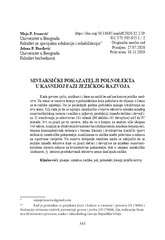Prikaz osnovnih podataka o dokumentu
Sintaksički pokazatelji polnolekta u kasnijoj fazi jezičkog razvoja
Sintactic indicators of genderlect in later language development
| dc.creator | Ivanović, Maja | |
| dc.creator | Đorđević, Jelena | |
| dc.date.accessioned | 2021-06-10T10:32:10Z | |
| dc.date.available | 2021-06-10T10:32:10Z | |
| dc.date.issued | 2020 | |
| dc.identifier.issn | 0522-8468 | |
| dc.identifier.uri | http://rfasper.fasper.bg.ac.rs/handle/123456789/1332 | |
| dc.description.abstract | Men and women use language means in various ways, the means of the same language, when they speak and write. This is the essence of genderlect theory which tries to explain what these differences are, and such theory incited numerous researches in current years. The aim of this work is to investigate syntactic features of youngest school age students' texts and differences in that production between boys and girls. 181 pupils participated in this research from the first, up to the fourth grade (96 boys and 85 girls). Each student wrote three essays, so there were 543 texts in this corpus. Our study included moth quantitative (the text length presented by a number of words, communicative sentences and clauses; the length of the sentence presented by a number of words and clauses) and qualitative (various sentences types) indicators. Differences between genders were analysed in comparison to researched variables. The results proved that there exist statistically significant differences in text length and sentence length in comparison to all measured parameters, i.e. girls produce longer texts and sentences than boys. When text structure is in question, it is important that the greatest number of complex sentences (compound, complex and complex-compound), are also constructed by girls. However, differences are not significant in relation, though they occur more often in the girls' texts. Our results show that there are certain quantitative differences between girls and boys at younger elementary school age with respect of some syntactic features, while in terms of syntactic maturity, i.e. the complexity of the produced texts there are no significant differences. | EN |
| dc.description.abstract | Kada govore i pišu, muškarci i žene na različite načine koriste jezička sredstva. Na tome se zasniva teorija o polnolektima koja pokušava da objasni u čemu se te razlike ogledaju, što je poslednjih godina podstaklo mnoga istraživanja na ovu temu. Cilj rada je da se ispitaju sintaksička svojstva tekstova učenika mlađeg osnovnoškolskog uzrasta i razlike u njihovoj produkciji između dečaka i devojčica. U istraživanju je učestvovao 181 učenik (96 dečaka i 85 devojčica) od I do IV razreda. Svi su pisali po tri sastava, tako da su u korpus za analizu ušla ukupno 543 teksta. Analiza je obuhvatila kvantitativne (dužina teksta izražena brojem reči, brojem komunikativnih rečenica i brojem klauza) i kvalitativne (različiti tipovi rečenica) sintaksičke pokazatelje. Analizirane su razlike među polovima u odnosu na ispitivane varijable. Na osnovu dobijenih rezultata može se zaključiti da se razlike između tekstova koje su pisali dečaci i devojčice na mlađem osnovnoškolskom uzrastu odnose na kvantitativne pokazatelje, dok u stepenu sintaksičke složenosti, tj. zrelosti produkovanih tekstova nema značajnih razlika. | SR |
| dc.publisher | Univerzitet u Beogradu - Filološki fakultet, Beograd | |
| dc.relation | info:eu-repo/grantAgreement/MESTD/Basic Research (BR or ON)/178002/RS// | |
| dc.relation | info:eu-repo/grantAgreement/MESTD/Basic Research (BR or ON)/179068/RS// | |
| dc.rights | openAccess | |
| dc.source | Anali Filološkog fakulteta | |
| dc.subject | writing | EN |
| dc.subject | syntax | EN |
| dc.subject | differences | EN |
| dc.subject | gender | EN |
| dc.subject | genderlect | EN |
| dc.subject | later language development | EN |
| dc.subject | pisanje | SR |
| dc.subject | sintaksa | SR |
| dc.subject | razlike | SR |
| dc.subject | pol | SR |
| dc.subject | polnolekt | SR |
| dc.subject | kasniji jezički razvoj | SR |
| dc.title | Sintaksički pokazatelji polnolekta u kasnijoj fazi jezičkog razvoja | EN |
| dc.title | Sintactic indicators of genderlect in later language development | SR |
| dc.type | article | |
| dc.rights.license | ARR | |
| dc.citation.epage | 361 | |
| dc.citation.issue | 2 | |
| dc.citation.other | 32(2): 345-361 | |
| dc.citation.rank | M51 | |
| dc.citation.spage | 345 | |
| dc.citation.volume | 32 | |
| dc.identifier.doi | 10.18485/analiff.2020.32.2.19 | |
| dc.identifier.fulltext | http://rfasper.fasper.bg.ac.rs/bitstream/id/286/1329.pdf | |
| dc.type.version | publishedVersion |


